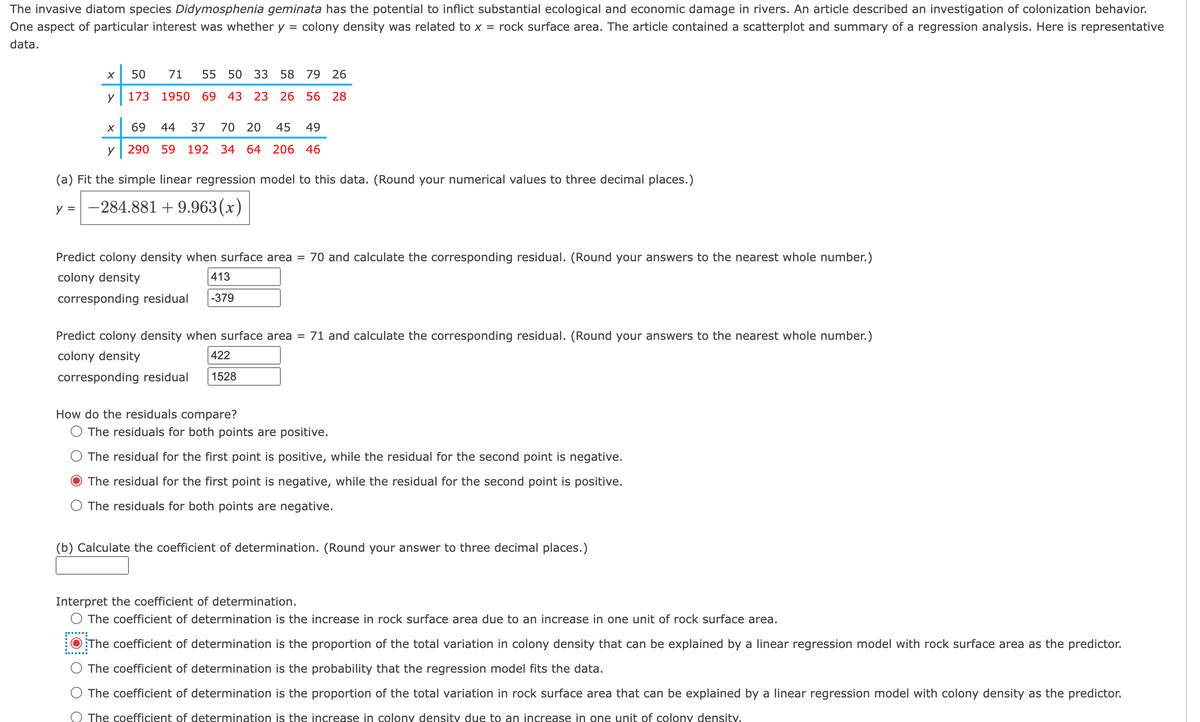e invasive diatom species Didymosphenia geminata has the potential to inflict substantial ecological and economic damage in rivers. An article described an investigation of colonization behavior. he aspect of particular interest was whether y = colony density was related to x = rock surface area. The article contained a scatterplot and summary of a regression analysis. Here is representative ta. x 50 71 55 50 33 58 79 26 y 173 1950 69 43 23 26 56 28 69 44 37 70 20 45 49 y 290 59 192 34 64 206 46 (a) Fit the simple linear regression model to this data. (Round your numerical values to three decimal places.) y = -284.881 + 9.963(x) Predict colony density when surface area = 70 and calculate the corresponding residual. (Round your answers to the nearest whole number.) colony density 413 corresponding residual -379 Predict colony density when surface area = 71 and calculate the corresponding residual. (Round your answers to the nearest whole number.) colony density 422 corresponding residual 1528
e invasive diatom species Didymosphenia geminata has the potential to inflict substantial ecological and economic damage in rivers. An article described an investigation of colonization behavior. he aspect of particular interest was whether y = colony density was related to x = rock surface area. The article contained a scatterplot and summary of a regression analysis. Here is representative ta. x 50 71 55 50 33 58 79 26 y 173 1950 69 43 23 26 56 28 69 44 37 70 20 45 49 y 290 59 192 34 64 206 46 (a) Fit the simple linear regression model to this data. (Round your numerical values to three decimal places.) y = -284.881 + 9.963(x) Predict colony density when surface area = 70 and calculate the corresponding residual. (Round your answers to the nearest whole number.) colony density 413 corresponding residual -379 Predict colony density when surface area = 71 and calculate the corresponding residual. (Round your answers to the nearest whole number.) colony density 422 corresponding residual 1528
Functions and Change: A Modeling Approach to College Algebra (MindTap Course List)
6th Edition
ISBN:9781337111348
Author:Bruce Crauder, Benny Evans, Alan Noell
Publisher:Bruce Crauder, Benny Evans, Alan Noell
Chapter3: Straight Lines And Linear Functions
Section3.CR: Chapter Review Exercises
Problem 15CR: Life Expectancy The following table shows the average life expectancy, in years, of a child born in...
Related questions
Question

Transcribed Image Text:(c) The second observation has a very extreme y value (in the full data set consisting of 72 observations, there were two of these). This observation may have had a substantial impact on the
fit of the model and subsequent conclusions. Eliminate it and recalculate the equation of the estimated regression line. (Round your values to three decimal places.)
y =
Does it appear to differ substantially from the equation before the deletion?
The new equation is substantially different.
The new equation is not substantially different.
What is the impact on r and s?
O r and s are both larger.
O r and s are both smaller.
O r2 is larger, while s is smaller.
Or is smaller, while s is larger.

Transcribed Image Text:The invasive diatom species Didymosphenia geminata has the potential to inflict substantial ecological and economic damage in rivers. An article described an investigation of colonization behavior.
One aspect of particular interest was whether y =
colony density was related to x = rock surface area. The article contained a scatterplot and summary of a regression analysis. Here is representative
data.
50
71
55 50 33
58 79
26
173
1950
69 43 23
26
56 28
69
44
37
70 20
45
49
y
290 59
192 34
64 206 46
(a) Fit the simple linear regression model to this data. (Round your numerical values to three decimal places.)
y = -284.881 + 9.963(x)
Predict colony density when surface area = 70 and calculate the corresponding residual. (Round your answers to the nearest whole number.)
colony density
413
corresponding residual
-379
Predict colony density when surface area = 71 and calculate the corresponding residual. (Round your answers to the nearest whole number.)
colony density
422
corresponding residual
1528
How do the residuals compare?
O The residuals for both points are positive.
The residual for the first point is positive, while the residual for the second point is negative.
The residual for the first point is negative, while the residual for the second point is positive.
The residuals for both points are negative.
(b) Calculate the coefficient of determination. (Round your answer to three decimal places.)
Interpret the coefficient of determination.
O The coefficient of determination is the increase in rock surface area due to an increase in one unit of rock surface area.
The coefficient of determination is the proportion of the total variation in colony density that can be explained by a linear regression model with rock surface area as the predictor.
The coefficient of determination is the probability that the regression model fits the data.
The coefficient of determination is the proportion of the total variation in rock surface area that can be explained by a linear regression model with colony density as the predictor.
O The coefficient of determination is the increase in colony density due to an increase in one unit of colony density.
Expert Solution
This question has been solved!
Explore an expertly crafted, step-by-step solution for a thorough understanding of key concepts.
This is a popular solution!
Trending now
This is a popular solution!
Step by step
Solved in 5 steps with 3 images

Recommended textbooks for you

Functions and Change: A Modeling Approach to Coll…
Algebra
ISBN:
9781337111348
Author:
Bruce Crauder, Benny Evans, Alan Noell
Publisher:
Cengage Learning


Glencoe Algebra 1, Student Edition, 9780079039897…
Algebra
ISBN:
9780079039897
Author:
Carter
Publisher:
McGraw Hill

Functions and Change: A Modeling Approach to Coll…
Algebra
ISBN:
9781337111348
Author:
Bruce Crauder, Benny Evans, Alan Noell
Publisher:
Cengage Learning


Glencoe Algebra 1, Student Edition, 9780079039897…
Algebra
ISBN:
9780079039897
Author:
Carter
Publisher:
McGraw Hill